Introduction to Python Loops
This chapter introduces how to use loop statements in Python.
Python has two types of loop statements: for and while.
Here is a control structure diagram of Python loop statements:
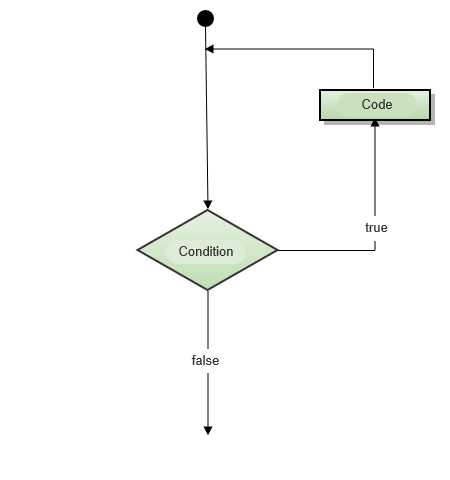
while Loop
The general syntax of the while statement in Python is as follows:
while condition:
statements
The flowchart for the while loop is shown below:
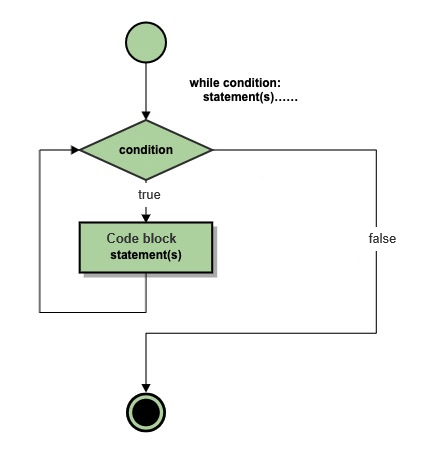
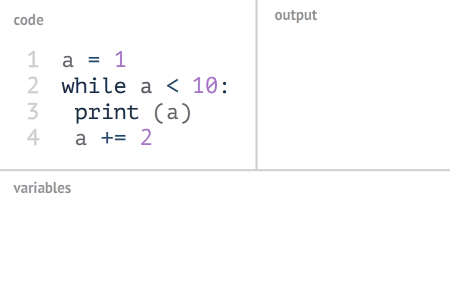
Execution Flow
-
The loop continues to execute as long as the condition is
True. -
Don't forget to use a colon (
:) and proper indentation.
Additionally, note that Python does not have a do...while loop.
Example
The following example uses a while loop to calculate the sum of numbers from 1 to 100:
#!/usr/bin/env python3
n = 100
sum = 0
counter = 1
while counter <= n:
sum = sum + counter
counter += 1
print("The sum from 1 to %d is: %d" % (n, sum))
Execution Result:
The sum from 1 to 100 is: 5050
Infinite Loop
We can create an infinite loop by setting the condition expression to never be False. Here's an example:
#!/usr/bin/python3
var = 1
while var == 1: # The expression is always true
num = int(input("Enter a number: "))
print("You entered: ", num)
print("Good bye!")
Execution Result:
Enter a number: 5 You entered: 5 Enter a number:
You can use CTRL+C to stop the infinite loop. Infinite loops are useful for handling real-time client requests on a server.
while Loop with else
When the condition in the while loop becomes False, the else block is executed.
Syntax:
while <expr>:
<statement(s)>
else:
<additional_statement(s)>
If the condition is True, the while block executes. If it's False, the else block executes.
Example
#!/usr/bin/python3
count = 0
while count < 5:
print(count, "is less than 5")
count = count + 1
else:
print(count, "is greater than or equal to 5")
Execution Result:
0 is less than 5 1 is less than 5 2 is less than 5 3 is less than 5 4 is less than 5 5 is greater than or equal to 5
Simple Statement Group
Similar to if statements, if the while loop contains only one statement, it can be written on the same line as the while keyword.
Example
#!/usr/bin/python
flag = 1
while (flag): print("Welcome to the tutorial!")
print("Good bye!")
Note: You can interrupt the above infinite loop by pressing CTRL+C.
Execution Result:
Welcome to the tutorial! Welcome to the tutorial! Welcome to the tutorial! ...
for Loop
The for loop in Python can iterate over any iterable object, such as a list or a string.
The general format of a for loop is as follows:
for <variable> in <sequence>:
<statements>
else:
<statements>
Flowchart:
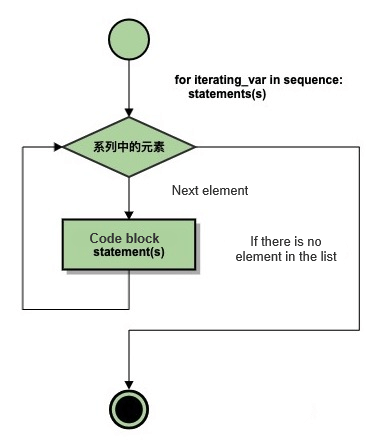
Example
#!/usr/bin/python3
sites = ["Baidu", "Google", "Runoob", "Taobao"]
for site in sites:
print(site)
Execution Result:
Baidu Google Runoob Taobao
You can also use a for loop to print each character in a string.
Example
#!/usr/bin/python3
word = 'runoob'
for letter in word:
print(letter)
Execution Result:
r u n o o b
Using range() with a for Loop
You can use the range() function to loop through a range of numbers.
Example
#!/usr/bin/python3
# All numbers from 1 to 5:
for number in range(1, 6):
print(number)
Execution Result:
1 2 3 4 5
for...else Statement
In Python, the for...else statement is used to execute a block of code after the loop has finished.
The syntax is as follows:
for item in iterable:
# Loop body
else:
# Code to execute after the loop finishes
When the loop completes (i.e., after iterating through all elements of the iterable), the code inside the else clause will be executed. However, if the loop encounters a break statement, it will exit the loop immediately, and the else clause will not be executed.
Example
for x in range(6):
print(x)
else:
print("Finally finished!")
Execution Result:
0 1 2 3 4 5 Finally finished!
In the following for loop example, a break statement is used to exit the loop early. In this case, the else clause will not be executed:
Example
#!/usr/bin/python3
sites = ["Baidu", "Google", "Runoob", "Taobao"]
for site in sites:
if site == "Runoob":
print("cainiao")
break
print("Looping through: " + site)
else:
print("No more data in the loop!")
print("Loop finished!")
When the loop encounters "Runoob", it will exit:
Execution Result:
Looping through: Baidu Looping through: Google cainiao Loop finished!
range() Function
If you need to iterate over a sequence of numbers, you can use the built-in range() function. It generates a sequence of numbers.
Example
>>> for i in range(5): ... print(i) ...
Execution Result:
0 1 2 3 4
You can also specify the start and end values for the range() function:
Example
>>> for i in range(5, 9):
print(i)
Execution Result:
5 6 7 8
You can make range() start at a specific number and use a custom step value (even negative numbers, which is sometimes called a 'step'):
Example with Positive Step
>>> for i in range(0, 10, 3):
print(i)
Execution Result:
0 3 6 9
Example with Negative Step
>>> for i in range(-10, -100, -30):
print(i)
Execution Result:
-10 -40 -70
You can also combine the range() function with len() to iterate over the indices of a sequence:
Example
>>> a = ['Google', 'Baidu', 'Runoob', 'Taobao', 'QQ'] >>> for i in range(len(a)): ... print(i, a[i]) ...
Execution Result:
0 Google 1 Baidu 2 Runoob 3 Taobao 4 QQ
Additionally, you can use the range() function to create a list:
Example
>>> list(range(5)) [0, 1, 2, 3, 4]
break and continue Statements and the else Clause in Loops
break Flowchart:
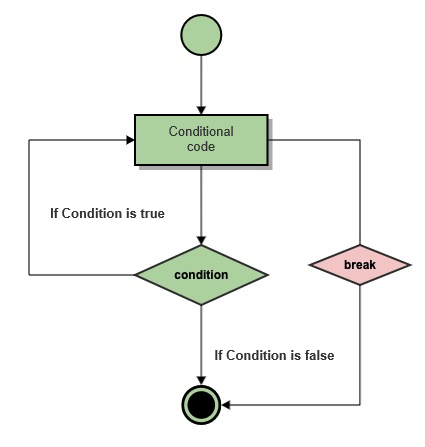
The break statement allows you to exit a for or while loop prematurely. If you terminate a loop using break, any corresponding else block will not be executed.
continue Flowchart:
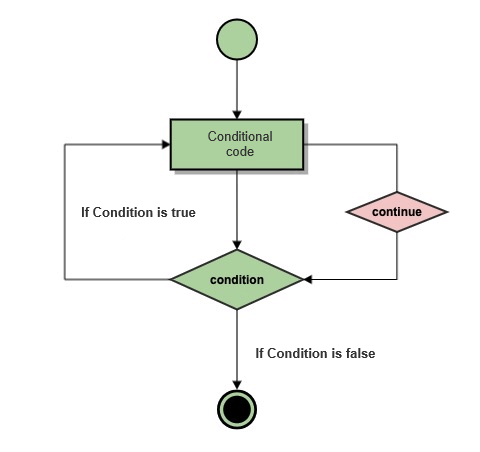
The continue statement is used to skip the remaining code inside the loop for the current iteration and move on to the next iteration.
Code Execution for while Statement:
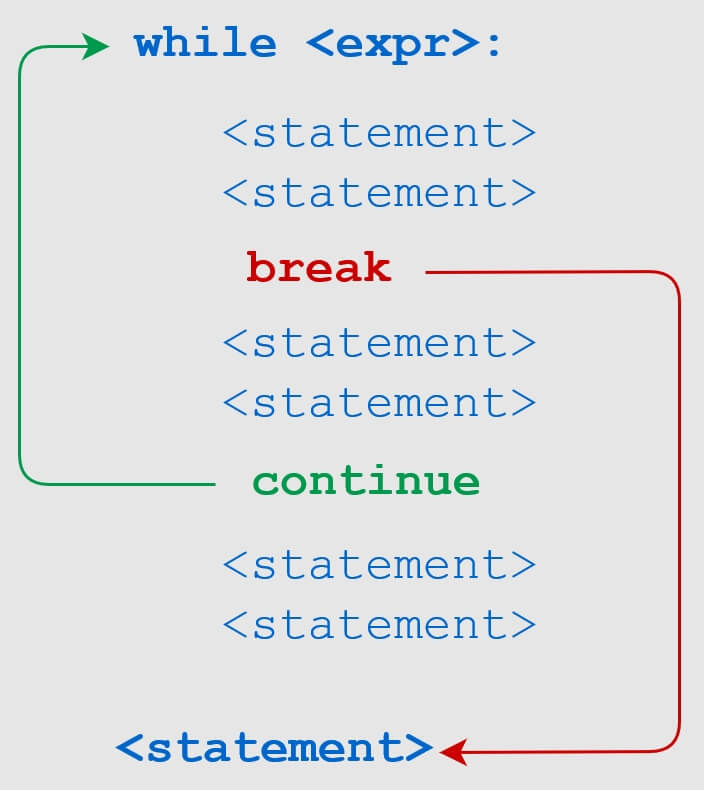
Code Execution for for Statement:
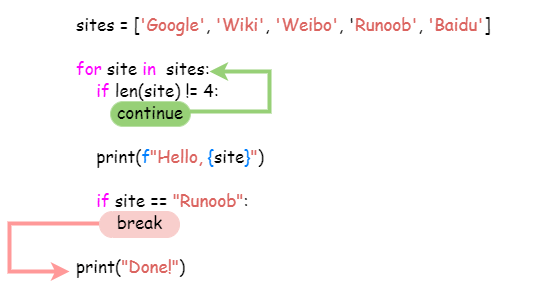
Using break in a while Loop
In the following example, break is used to exit the while loop:
Example
n = 5
while n > 0:
n -= 1
if n == 2:
break
print(n)
print('Loop ended.')
Output:
4 3 Loop ended.
Using continue in a while Loop
The continue statement skips the rest of the code and proceeds with the next iteration of the loop:
Example
n = 5
while n > 0:
n -= 1
if n == 2:
continue
print(n)
print('Loop ended.')
Output:
4 3 1 0 Loop ended.
More Examples
Example 1
In this example, we use break to exit the loop when the letter 'b' is encountered:
#!/usr/bin/python3
for letter in 'Runoob': # First example
if letter == 'b':
break
print('Current letter:', letter)
var = 10 # Second example
while var > 0:
print('Current variable value:', var)
var -= 1
if var == 5:
break
print("Goodbye!")
Output:
Current letter: R Current letter: u Current letter: n Current letter: o Current letter: o Current variable value: 10 Current variable value: 9 Current variable value: 8 Current variable value: 7 Current variable value: 6 Goodbye!
Using continue to Skip Loop Iterations
In this example, we skip printing the letter 'o':
Example 2
#!/usr/bin/python3
for letter in 'Runoob': # First example
if letter == 'o': # Skip 'o'
continue
print('Current letter:', letter)
var = 10 # Second example
while var > 0:
var -= 1
if var == 5: # Skip when var is 5
continue
print('Current variable value:', var)
print("Goodbye!")
Output:
Current letter: R Current letter: u Current letter: n Current letter: b Current variable value: 9 Current variable value: 8 Current variable value: 7 Current variable value: 6 Current variable value: 4 Current variable value: 3 Current variable value: 2 Current variable value: 1 Current variable value: 0 Goodbye!
else Clause in Loops
Loops in Python can have an else clause, which is executed when the loop exhausts the list (in for loops) or when the condition becomes False (in while loops). However, if the loop is terminated by a break statement, the else clause will not execute.
Here is an example that uses loops to find prime numbers:
Example
#!/usr/bin/python3
for n in range(2, 10):
for x in range(2, n):
if n % x == 0:
print(n, 'equals', x, '*', n//x)
break
else:
# Loop did not find a factor
print(n, 'is a prime number')
Output:
2 is a prime number 3 is a prime number 4 equals 2 * 2 5 is a prime number 6 equals 2 * 3 7 is a prime number 8 equals 2 * 4 9 equals 3 * 3
pass Statement
The pass statement in Python is a null statement. It is used when a statement is required syntactically but you do not want to execute any code. It is generally used as a placeholder.
Example: pass in a Loop
>>> while True: ... pass # Waiting for keyboard interrupt (Ctrl+C)
Minimal Class Example
>>> class MyEmptyClass: ... pass
Example: Using pass in a Loop
#!/usr/bin/python3
for letter in 'Runoob':
if letter == 'o':
pass
print('Executing pass block')
print('Current letter:', letter)
print("Goodbye!")
Output:
Current letter: R Current letter: u Current letter: n Executing pass block Current letter: o Executing pass block Current letter: o Current letter: b Goodbye!




